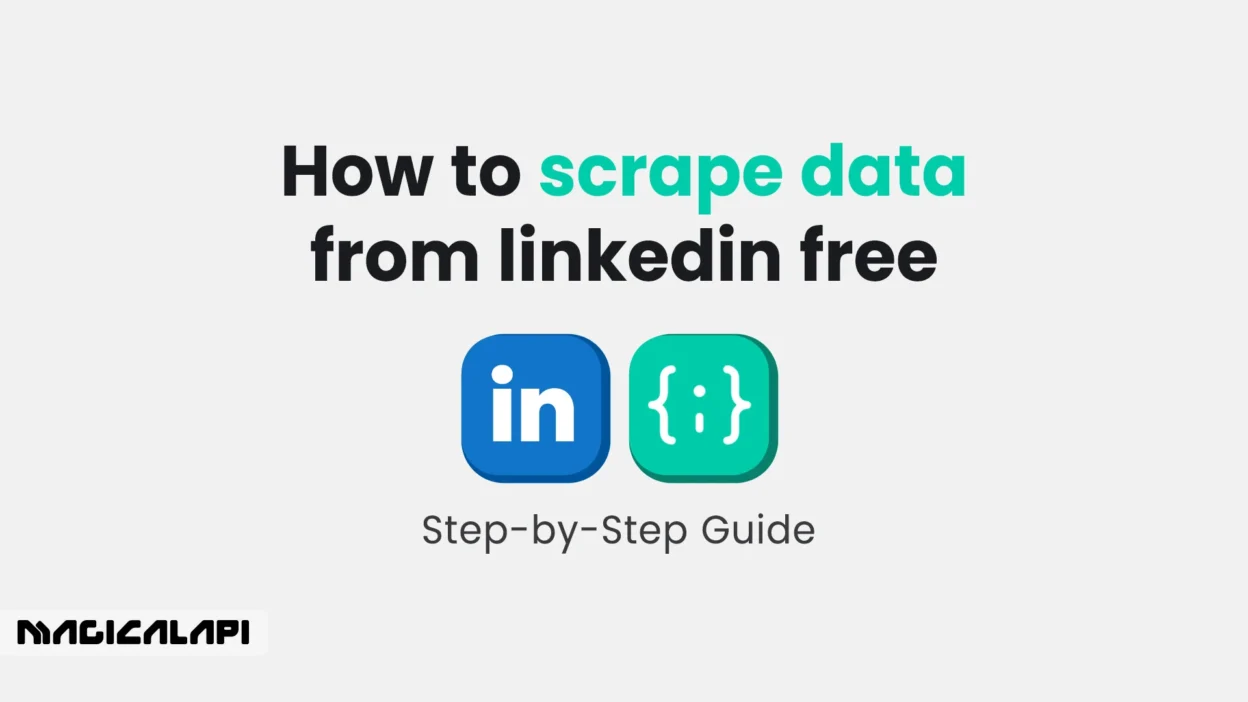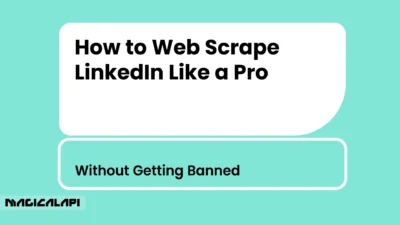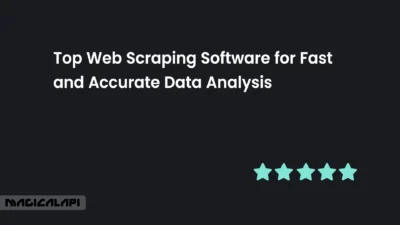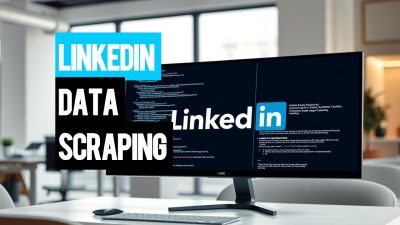LinkedIn is an absolute treasure trove of professional data, containing limitless potential for lead generation, recruitment, market research analysis, and more. The problem is often how to access that data easily and in bulk. Most people think you need to pay a lot of money for a premium subscription or purchase fancy software and subscription services.
The good news is you can scrape data from LinkedIn free of charge! There are all kinds of ways to do this, from using LinkedIn features to export connections to using external web scraping tools that offer free pricing plans or trial periods that allow you to Get Company Profile Data information for free.
This guide will cover everything you need to get started. We will discuss the best tools, provide a step-by-step tutorial of using a powerful API, and discuss how you can scrape responsibly.
Table of Contents
What Does It Mean to Scrape Data from LinkedIn?
LinkedIn data scraping is the automated retrieval of public information from LinkedIn profiles, company pages, and job postings. Scraping is faster and less error-prone than copying and pasting information from LinkedIn manually (one by one) using automated software “bots” or APIs to scrape the data and get it into a usable format-like a CSV file or a JSON object.
Here are examples of the types of data that you will usually be able to scrape:
- Personal Profile Data: Name, Job Title, Current and Past Companies, Education, Skills, and Connection count.
- Company Page Data: Name, Industry, Size, Location, Website, and Employees.
- Job Posting Data: Job Title, Company, Location, Job Description, and Job Skills.
- Group data: Information about LinkedIn groups, including group names, descriptions, member counts, and more.
- Read More: How to Export LinkedIn Data to Excel?
In many instances, this structured data is very valuable for sales teams prospecting, recruiters looking to identify top talent, and marketers looking for trends in an industry.
Read More: How to Get Phone Numbers from LinkedIn?
What is LinkedIn Data Scraping?
LinkedIn data scraping refers to an automated process of extracting valuable information from the social media platform, LinkedIn, the world’s largest professional networking platform.
These tools, known as LinkedIn scrapers, can pull out a range of data from a user’s LinkedIn profile, job listings, company information, and more. This data can then be utilized for various applications like market research, lead generation, recruitment, and competitor analysis.
There are two main approaches to LinkedIn scraping: manual and automated.
1. Manual LinkedIn scraping
The manual approach involves coding, particularly using Python, and leveraging libraries such as BeautifulSoup and requests to parse HTML content and extract data. This method is cost-effective as it relies on free libraries and tools but requires a basic understanding of coding.
2. Automated LinkedIn scraping
Automated scraping tools simplify the process by navigating the LinkedIn Scraper based on set instructions. These tools can vary in terms of features, capabilities, and price, making it essential to choose one that fits your specific needs.
Some tools are designed for more comprehensive data extraction, including profile details, skills, group memberships, and educational background, while others focus on specific data points like names, job titles, and company information. Some scrapers also offer automation features, such as scheduling scrapes, customizing data fields to be extracted, and integrating scraped data with other applications or CRM tools.
Using an automated LinkedIn scraper requires selecting a tool that fits your specific needs in terms of features, ease of use, and pricing.
Is it Legal to Scrape LinkedIn Data?
This is one of the easier questions. However, there is a slight nuance to it. In many jurisdictions, scraping of publicly available data is legally acceptable as confirmed by several court decisions, one of the more high-profile cases being hiQ Labs v. LinkedIn.
However, scraping data from LinkedIn is specified in their User Agreement as something that is not allowed. In other words, while you may not be breaking the law by scraping public data, you are still violating LinkedIn’s terms of service. Therefore, your account could face action from LinkedIn, such as account throttling and/or getting banned altogether.
So, as a rough guide, here are 3 suggestions to stay on the safe side.
- Only scrape public data: If it is in a log-in (protected) area or if it is not visible to the public, don’t scrape it.
- Scrape responsibly: Don’t send a bunch of requests in a short period (be nice to the servers). Not-for-profit and high-quality tools will include limits to prevent the user from overwhelming the site.
- Responsibly use scraped data: Don’t use it for spam, threats, unwanted association, etc.
Top Free Tools for Scraping LinkedIn Data
There are several options available when you’re trying to figure out how to scrape LinkedIn data for free? And they all come with their advantages and disadvantages.
- Browser Extensions: Browser extensions, or plugins that you add to your web browser (like Chrome). They are usually simple to operate, but they are usually slow and unreliable, especially if LinkedIn updates its website layout. These extensions usually operate on your computer (locally), so they use your computer’s resources.
- Desktop Applications: Desktop applications are standalone software that you install on your computer. They have more computing power compared to extensions, but they come with many of the same limitations. For example, they rely on your IP address, which can get blocked.
- Cloud-Based APIs: Application Programming Interfaces (APIs) provide a more robust and scalable solution. APIs will do the scraping infrastructure for you (including proxy management and HTML parsing) and just return the clean, structured data directly into your application.
There are many different tools that you can use and many APIs out there, but MagicalAPI is the best because they have a powerful and reliable API with a large free plan, seeing as many or most of the people are just looking to get into something without starting off with a financial investment.
How to Scrape LinkedIn Profiles Free with MagicalAPI
MagicalAPI aims to simplify your data extraction experience. It is an intermediary service, extracting data from public material on LinkedIn pages and returning it in a clean, machine-readable JSON response.
This way, you will not have to build and maintain your scrapers, maintain functionality when the site alters an access point, or maintain your proxy network to avoid leaving footprints and achieving blocking status.
MagicalAPI provides a topic-specific Linkedin Profile Scraper that is highly optimized to extract rich detail from individual profiles with a single API request.
LinkedIn Profile Scraper - Profile Data
Discover everything you need to know about LinkedIn Profile Scraper , including its features, benefits, and the different options available to help you extract valuable professional data efficiently.
Step-by-Step: Use MagicalAPI to Scrape LinkedIn Data
Let’s get down to business. There is no need to delay – here is how you can go from zero to scraping your first LinkedIn profile in a matter of minutes on MagicalAPI’s free plan.
Step 1: Sign Up For A Free MagicalAPI Account
To begin, go to the MagicalAPI website and sign up for your free account. The free plan gives you credits each month, which is easily enough to scrape hundreds of profiles and evaluate the service.
Step 2: How To Get Your API Key
When you have registered for your account and gone to your dashboard, you will see your unique API key. The API Key is your unique identifier that authenticates your requests for scraping. Treat it like a password – do not share it and keep it private.
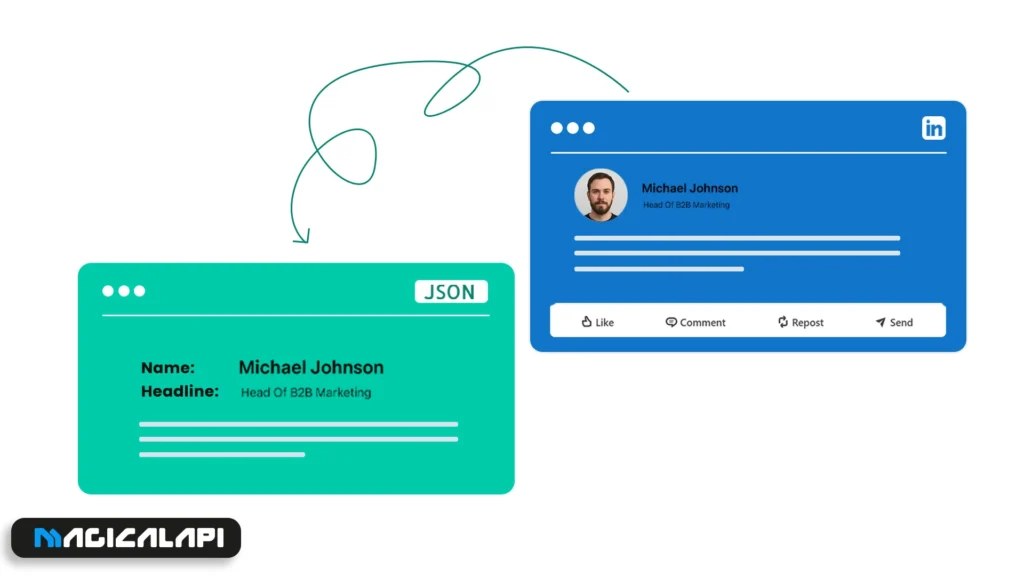
Step 3: Find a Public LinkedIn Profile URL
Next, locate the public LinkedIn profile that you want to scrape. For this example, we will scrape a fictional person’s profile, but the URL will look similar to: https://www.linkedin.com/in/john-doe-12345/.
Step 4: Make the API Request
Now we are going to make the API request to retrieve the data. You could use any programming language (like Python or JavaScript) or even a command-line tool like cURL.
Here is an example using cURL in the command line. Remember to replace ‘YOUR_API_KEY’ with the key you found in your dashboard and replace the profile URL with the profile you would like to scrape.
\\curl -X POST 'https://magicalapi.com/api/v1/linkedin/profile/scrape' \
-H 'Content-Type: application/json' \
-H 'x-api-key: YOUR_API_KEY' \
-d '{
"url": "https://www.linkedin.com/in/john-doe-12345/"
}'\\Step 5: Obtain the Structured Data
MagicalAPI will make the request and, within seconds, respond with a structured JSON object containing all the information that has been scraped. The output could look like this (example shortened for purposes of clarity):
\\{
"data": {
"full_name": "John Doe",
"headline": "Software Engineer at Tech Company",
"location": "San Francisco, California, United States",
"summary": "Experienced software engineer specializing in...",
"experience": [
{
"title": "Software Engineer",
"company_name": "Tech Company",
"duration": "Jan 2022 - Present"
}
],
"education": [
{
"school_name": "University of Technology",
"degree": "Bachelor of Science in Computer Science"
}
]
// ... and much more data
},
"meta": {
"id": "request-id-123",
"request_credits_cost": 10
}
}\\That’s it! You’ve successfully scraped a LinkedIn profile and have the data neatly organized and ready to use.
LinkedIn Scraper API vs Browser Extensions: Which Is Better?
When deciding how to approach data extraction, it’s crucial to understand the difference between using an API and a browser extension.
| Feature | LinkedIn Scraper API (e.g., MagicalAPI) | Browser Extension |
| Scalability | High. Can make thousands of requests programmatically. | Low. Limited to manual clicks and your browser’s speed. |
| Reliability | Very High. Maintained by a dedicated team to handle site changes. | Low. Frequently breaks when LinkedIn updates its code. |
| Speed | Fast. Optimized cloud infrastructure for quick data retrieval. | Slow. Runs locally and is limited by your connection and PC. |
| Blocking Risk | Low. Uses a large, managed pool of proxies to avoid blocks. | High. Uses your IP, which can be easily flagged and banned. |
| Integration | Easy. Delivers structured data (JSON) for direct use in apps/databases. | Difficult. Often requires manual export to a CSV file. |
| Resource Use | None. All processing is done in the cloud. | High. Consumes your computer’s CPU and memory. |
A browser extension is a decent option for a one-off scraping job or to scrape very infrequently. However, if you are serious about using LinkedIn as a data source, a LinkedIn Scraper API (such as MagicalAPI) is the best option for data extraction. A LinkedIn scraper is more reliable, better scalable, safer, and will give you cleaner data to use in your workflow.
Read More: AI Data Scraping Explained
How to Scale LinkedIn Scraping Without Paying for Sales Navigator
It’s a myth to believe that a pricey LinkedIn sales navigator subscription is needed for large-scale data collection. Sales Navigator is great for manual prospecting, but you can go much deeper, at scale, programmatically. The way to think of how to scrape data from LinkedIn for free and at scale is automation, through an API.
The great part about MagicalAPI is that you only have to write a simple script to iterate through a list of LinkedIn profiles or company URLS.
You can do the following:
- Scrape “THOUSANDS” of Profiles: You can build a script (to put into your favourite programming language) that supplies a list of profile URLs to the MagicalAPI endpoint, which can then save the results into a database or spreadsheet.
- Enrich Existing Data: If you have a list of names or companies, you can use a search engine to get their LinkedIn URLS and then use the API to enrich the data with up-to-date information.
- Open Up Automated Company Research: Use the Linkedin Company Scraper to take an account’s company data, collect for target accounts, and track employee size, decision makers, etc.
- Leveraging an API means that you are not manually limited by a person and rate-limited to your account, and you can build an entire data set without paying for premium subscriptions.
LinkedIn Company Scraper - Company Data
Discover everything you need to know about LinkedIn Company Scraper , including its features, benefits, and the various options available to streamline data extraction for your business needs.
Avoiding Common Pitfalls When Scraping LinkedIn
Your scraping project should be a success and completed ethically. You should take some things into account as follows:
- Don’t Overwhelm: Even an API can clamp down on you if you send an alarming number of requests at once. A good API provider is doing some of that work for you, but if building your own solution, then make sure to include appropriate delta requests.
- Plan for Variance: Not all LinkedIn profiles have the same structure. You might not have a summary, there could be different education formats, and some profiles may leave off pieces of information. Make sure that your code is resilient and can work through the variance of profiles and not break.
- Don’t Scrape Just to Scrape: Do not scrape just to scrape! There needs to be an intention. For instance, scraping leads within an industry? Candidates with a specific skill? Having details will drive more meaningful data acquisition, and you will find value in your results.
- Protect your Data: The professional data you will scrape will be private. Make sure that you save it in a secure database. Only save what you need and make sure that you comply with your data privacy procedures (e.g., GDPR).
Use Cases: Who Benefits Most from Free LinkedIn Data Scraping?
A plethora of professions can benefit greatly from LinkedIn data.
- Sales & Business Development: Businesses can create plenty of lists for potential leads depending on the industry type, company size, geography, and title. Not only does this data feed the outbound campaign, but it also adds to a business CRM record.
- Recruiters & Staffers: To find passive candidates who are not applying. To check candidate credentials/or to build a talent pipeline to place candidates later on.
- Marketer: Market research using LinkedIn to introduce you to your audience, look at competitors’ employee profiles, and industry trends.
- Academics & Researchers: To collect data for a social science study, an economic study, or a labor market analysis.
- Job Seekers: To research companies based on interest, find potential connections to connect with, and keep track of what skills are desirable for certain positions.
Essential Dos and Don’ts for LinkedIn Data Scraping
When it comes to scraping data from LinkedIn, there are some important do’s and don’ts to keep in mind to ensure that your activities are responsible, ethical, and in line with legal and platform guidelines. Here’s a breakdown:
Do’s:
- Understand LinkedIn’s Terms of Use: Before you start scraping, make sure you’re familiar with LinkedIn’s terms of service. They have specific clauses about automated data extraction.
- Use Publicly Available Information: Focus on publicly available data that doesn’t require logging in or bypassing any form of authentication.
- Be Respectful of Data Privacy: Even when data is public, consider the privacy of individuals. Don’t use scraped data for purposes that individuals have not consented to.
- Limit Your Request Rate: To avoid overloading LinkedIn’s servers, make sure to limit the frequency of your scraping requests to a reasonable rate.
Don’ts:
- Don’t Ignore LinkedIn’s Robots.txt: This file on LinkedIn’s server provides guidelines on what parts of the site can be crawled by bots. Ignoring it can lead to legal issues.
- Don’t Scrape Protected Data: Avoid any attempt to scrape data that’s not publicly accessible without appropriate permission. This includes data behind login protections or other access controls.
- Don’t Use Scraped Data for Spam or Malicious Activities: Using data collected from LinkedIn to spam or engage in unauthorized marketing activities can lead to legal consequences and platform bans.
- Don’t Overload LinkedIn’s Servers: Sending too many requests in a short period can be considered a denial of service attack, which is illegal.
Understanding and adhering to these guidelines is crucial for conducting LinkedIn scraping activities ethically and legally. Always prioritize transparency, respect for privacy, and adherence to legal standards in your data collection practices. Given the evolving nature of legal interpretations around web scraping, staying informed about current laws and court rulings in your jurisdiction is also important.
Read More: How to Web Scrape LinkedIn?
The Future of LinkedIn Scraping
As technologies like AI and machine learning continue to evolve, they’re expected to enhance LinkedIn scraping techniques, helping businesses extract even more valuable insights from LinkedIn data. However, as these technologies advance, businesses must also remain vigilant about privacy and ethical considerations.
Conclusion: MagicalAPI can stop worrying about technical setups
Today, learning how to scrape data from LinkedIn free will equip you with an invaluable skill situated in our data-heavy world. While a common manual and extensions exist to help scrape LinkedIn, they don’t provide the power, reliability, and scalability of a scraping API.
When you leverage something like MagicalAPI, you can stop worrying about technical setups and start thinking about what you should be thinking about: using high-quality, structured data to achieve your business objectives. Whether that means building a lead list, acquiring talent, or developing research capabilities, a scraping API first will provide you with a professional service at a fraction of the cost of hiring in-house or a consultancy.
FAQs for how to scrape data from LinkedIn free
1. How can I scrape free LinkedIn data?
You can scrape free LinkedIn data by using tools such as MagicalAPI, which has a comprehensive free plan for making API requests that let you programmatically scrape public data from made profiles and company pages, even if you do not have a paid subscription. Other options include open-source libraries (if you can code!) or browser extensions that have free plans, although the APIs are typically more reliable.
2. Is data scraping from LinkedIn illegal?
Scraping public data is not illegal, but scraping public data is a violation of LinkedIn’s Terms of Service. Even if you are scraping publicly available data, your account has the risk of being restricted or banned. To limit your risk, scrape responsibly, use a tool that manages proxies well, and never scrape data behind a login.
3. What’s the best free tool to scrape from LinkedIn?
An API-based tool like MagicalAPI tends to be the best option for reliability, scalability, and simplicity. They do the hard work for you (the proxies, parsing), you get your structured data back, and you can do all that for free for a plan that will suit many projects.
4. How much data can I scrape for free?
This will depend on what tool you use. When you use MagicalAPI, the free plan has a monthly quota of API credits, which typically allows you to scrape hundreds of profiles or company pages each month. This is ideal for small to medium-sized projects, testing, and development.


